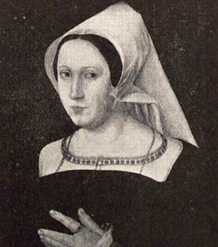The Last Three Wives
Marriage annulled: Anne of Cleves
After Jane Seymour's death, Henry waited for more than two years before marrying Anne of Cleves. Because of the isolation caused by England's break with Rome, Henry set about searching for a bride who could help him secure new alliances. Henry's emissaries in foreign courts were instructed to send him reports detailing the qualities of various foreign ladies. One of the women who met Henry's criteria was Anne of Cleves, the sister ofthe Duke of Cleves, a potential ally, and when he sent Hans Holbein to paint her portrait, he was sufficiently pleased with her looks to have a marriage contract drafted.
Nevertheless, by the time the marriage took place in January 1540, Henry was already looking for ways to get out of the marriage. It was immediately clear that Anne was ill prepared for life at the English court: unlike her predecessors, she had not received a humanist education, and Henry, despite his initial approval of her portrait, was unimpressed with her looks,calling her, as legend has it, a "Flander's Mare." Moreover, Anne's brother was becoming embroiled in a conflict with the Empire, and Henry did not want to be drawn into war.
Despite Anne's lack of formal education, she was sufficiently astute not to oppose Henry's attempts to annul their marriage. She testified that their marriage had not been consummated, and that a previous engagement was improperly broken. Her willingness to acquiesce to Henry's plans ensured that she escaped the fate of her successor, and after the marriage was dissolved (only six months after the wedding) she received the honourary title of "King's Sister," and was given property, including lands that had previously belonged to Anne Boleyn. Anne of Cleves lived quietly in the English countryside until her death in July 1557.
Executed: Catherine Howard
While Henry denigrated Anne of Cleves as a "Flander's Mare," he praised his fifth wife, Catherine Howard, as a "rose without a thorn" and the "very jewel of womanhood." Catherine, the daughter of Lord Edmund Howard and the cousin of Anne Boleyn, came to court at the age of 19 as a Lady in Waiting for her predecessor, Anne of Cleves. It is likely that Henry's infatuation with Catherine led, in part, to his divorce with Anne of Cleves, for Catherine and Henry were married, ages 19 and 49 respectively, only sixteen days after the nullification of Henry's previous marriage.
Henry lavished gifts on his young and beautiful bride, but within less than a year rumors of Catherine's infidelity began to circulate. For a woman in Catherine's position, even minor flirtations could give her political enemies leverage over her, and she did not help matters by appointing one of her admirers as her personal secretary. By November 1541 Archbishop Cranmer had collected enough evidence to make a case before Henry. At first Henry did not believe the accusations; however, he allowed the investigation to continue, and eventually enough evidence was gathered to convince Henry. Catherine was executed in February 1542.
Survived: Katherine Parr
Katherine Parr, Henry's sixth wife, was the daughter of Thomas Parr of Kendal, a country squire who had served both Henry VII and Henry VIII. Before marrying Henry, Katherine had been married and widowed twice before, and during these marriages she gained a reputation for her learning, piety, and caring nature. No doubt these were qualities desired by Henry, for Katherine was both wife and nurse to him in his old age.
Once she became Queen, Katherine became a stabilizing force in Henry's household, functioning as a mother figure for Elizabeth and Edward. Catherine also influenced government policy by restoring Mary and Elizabeth to the royal succession, from which they had been excluded as bastards, as well as by protecting universities and attracting reform minded humanists to the court, some of whom tutored young Prince Edward and Princess Elizabeth.
However, Katherine's Protestant interests almost caused her to share her predecessor's fate: factions at court who resented Katherine's influence brought her up on charges of heresy, from which she escaped by publicly submitting to her husband's will. Katherine survived Henry, who died in January 1547, but died only one year later in childbirth, after marrying Thomas Seymour (who had previously sought her hand, but was frustrated by Henry's interest in her).
Katherine Parr was also a significant woman writer of her day, writing Lamentation of a Sinner (1547).
Laura Eakins has a good web site on The Six Wives of Henry VIII. EnglishHistory.net also has good resources.

